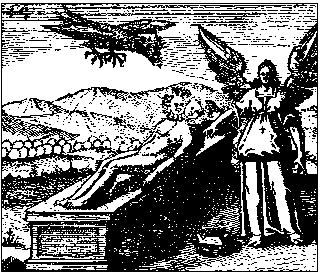
Transformation
Transformation
Transformation

| Transformation Transformation Transformation |
The distinguishing feature of Perennialist Work is its power to produce intellectual, psychic, spiritual, and moral upheaval in a prepared mind and transport that mind to a higher dimension and non-terrestrial domains of being and meaning for the purpose of engaging in the process of transforming that person from an ordinary terrestrial being into a supersensible adept. I am using the term "Perennialist Work" to include the conscious production or arrangement of words, sounds, colors, forms, movements, or other elements in Perennialist essays, diagnoses, assignments, dialectical interchanges, initiation rites, Websites, and other activities and productions.
Upheaval is required to displace the psyche--mind and personality--from its entrenched intellectual and emotional routines. The outcome of Perennialist Work is not some vague feeling of uplift or emotion in an adept or initiate; it is an eruption within the soul, it is complete transformation from a quotidian (everyday, mundane, routine, unremarkable, workaday) state of being into a higher state of being.
This essay will present one specific exemplification of how a Perennialist teacher "works" with students (or initiates) to allow for psychic and spiritual upheaval in them to enable soul transformation. The process only allows for the possibility of upheaval and transformation; it does not automatically, magically, or with absolute certainty produce either. The desired result of psychic and spiritual upheaval and transformation depends on how well the student has prepared for the learning experience.
This exemplification can only refer to or illustrate such an exercise or learning experience; it cannot automatically "cause" or "reproduce" such an episode. But if readers are sufficiently advanced in their "work," they may be able to experience actual psychic and spiritual upheaval and transformation.
The teacher explains that this exercise is one of anagogical theurgy. The word "anagogy" derives from the Greek anagein: to lift up, exalt, heighten, upheave, or intensify. Anagogy refers to the potency of certain "esoteric" entities or activities (such as a poem, a book, an initiation ritual, an image, a person, or a Cathedral) which transport persons beyond themselves to a higher state of consciousness. The kind of "transport" that anagogy provides differs from the potency of a psychedelic drug that "propels" us to new--not often higher--experiences whether or not. In Perennialist upheaval, our powers and capabilities are deliberatively involved in the uplift to another dimension or realm.
"It is through communicating with higher spiritual beings by means of Theurgical Dialectic that humans come to true realization of what they are in essence: eternal spiritual entities."
Iamblicus, On the Mysteries
The linguistic and artistic elements within Perennialist teaching material strain against their conceptual bounds; the anagogical forces overpower the ordinary meanings, allowing us to ascend to an actual participation in a divine Beyond. The evocative and transformative power of the material far outstrips the merely informative capacity and we move into higher realms of meaning and effect.
Ordinary communication:
The message passes from the initiator to the recipient, possibly being corrupted by static and either enhanced or degraded by the recipient's disposition. Anagogical communication:
The message originates in the Transcendent Realm, is manifested through the initiator, passes through static and the filter of the recipient's dispositional elements, then lifts the recipient up to the Transcendent Realm.
Thus, when a Perennialist teacher carries out a Perennialist anagogical upheaval exercise, involving the "exposure" of an initiate, who has evinced the necessary qualities and capabilities, to anagogical content (entity, element, phenomenom, reality), the teacher is, at the same time, engaging in anagogical Work within the framework of Platonic dialectical interchange.In this way the initiate has the opportunity to experience the anagogical dynamism of "esoteric" words and phrases that can (not necessarily or automatically will) transport and elevate him or her to the supersensible realm.
An anagogical Work of Perennialist Upheaval and Transformation must be masterfully crafted and orchestrated by the Perennialist teacher, because each least-seeming element is contributory to the ultimate goal: the consciousness up-bursting to New, Unfamiliar universes, realities, and domains. For example, the presentation of anagogical words and phrases must be in efficacious tempo, order, meter, and emphasis. The timing, for example, must be masterfully controlled, allowing for essential pause and rapidity in their proper happenstance. What elements are efficacious or not is Higher Knowledge. Each element and nuance of the anagogical material, each word, each meaning, each sound, each connection to other words, each rhyme with another word, each metaphor--each inflection or innuendo--all these possess the power to produce Perennialist upheaval.
The crucial element in Perennialist Work is the teacher. He must possess the Higher Knowledge of what actualities and particularities possess the transcendent puissance (power to influence or coerce) to effect each desired outcome, how the various parts and factors interact to actualize higher consciousness. The particular poem highlighted in this essay's exemplification of Perennialist transformative exercises could be chosen by, let us say, a college English instructor by happenstance, without any knowledge whatsoever of the underlying potencies of this poem. This instructor would be unaware that this particular poem possesses the esoteric potency it does, would have no understanding of mystic upheaval or transcendence, so would be totally unable to "use" the poem for any purpose other than ordinary illustration. The Perennialist teacher must possess esoteric knowledge of what elements and aspects possess power, what specific elements are efficacious, and how to utilize, intermingle, separate, emphasize, and ignore each aspect with the correct emphasis and timing. He must also possess transcendental understanding of how to act on and interact with each particular student to produce specific desired outcomes, effects, and distillates.
The teacher reads or texts the poem (aloud if they are in physical proximity and via text if the interchange is by online chat). Each word and each phrase is presented separately, because the sound or meaning of any word or phrase can produce instantaneous mind-upheaval or mind-exaltation. The student is instructed to attempt to "discern" what verbal, emotional, and psychic response/reaction the specific words and phrases are activating in him and what meanings are being inspired in him and what effect each word and phrase is having on him. In more prosaic terms, the student reports specifically how the material is knocking him into a higher dimension or alternate reality.
The student is encouraged to verbalize any reactions and meanings he is experiencing/feeling/being inspired by that he feels are significant. The teacher and student discuss the words, meanings, upheavals, and transformations they are experiencing jointly and separately.
The speficic illustration contained in this essay pertains to the use of an esoterically-chosen poem to act as the catalyst 1 for the upheaval and transformation effect. This illustration/essay is also used as an initiation ritual with selected student/initiates.
Poem
| | Thirteen Ways of Looking at a Blackbird 2 I Among twenty snowy mountains, The Only moving thing Was the eye of the blackbird. II I was of three minds, Like a tree In which there are three blackbirds. III The blackbird whirled in the autumn winds. It was a small part of the pantomime. 3 IV A man and a woman Are one. A man and a woman and a blackbird Are one. The beauty of inflections 4 Or the beauty of innuendoes, 5 The blackbird whistling Or just after. With barbaric glass. The shadow of the blackbird Crossed it, to and fro. The mood Traced in the shadow An indecipherable cause. Why do you imagine golden birds? Do you not see how the blackbird Walks around the feet Of the women about you? And lucid, inescapable rhythms; But I know, too, That the blackbird is involved In what I know. It marked the edge Of one of many circles. Flying in a green light, Even the bawds 6 of euphony 7 Would cry out sharply. In a glass coach. Once, a fear pierced him, In that he mistook The shadow of his equipage For blackbirds. The blackbird must be flying. It was snowing And it was going to snow. The blackbird sat In the cedar-limbs. | |

1 Catalyst: An element (object, person, procedure) that precipitates a process, event, or outcome
2 This was the poem I shared/experienced with my current Perennialist teacher during one of our first Perennialist joint-experiences.
3 Pantomime: any of various dramatic or dancing performances in which a story is told by expressive bodily or facial movements of the performers
4 Inflection: The process of pronouncing a word in a particular manner or tone to express different moods, emphases, meanings, or approval or disapproval
5 Innuendo: a hint, insinuation or intimation about an entity (person, object, event) especially of a denigrating or a derogatory nature, often to insult or accuse in such a way that one's words, taken literally, seem innocent
6 Bawd: A woman who is boisterously or humorously indecent; a bawd solicits customers for a person who provides specific types of pleasure
7 Euphony: agreeable (pleasing and harmonious) sounds; phonaesthetics is the claim or study of inherent pleasantness or beauty (euphony) or unpleasantness (cacophony) of the sound of certain linguistic utterances. Good poetry is often considered euphonic, as is well-crafted literary prose. Important phonaesthetic devices of poetry are rhyme, assonance and alliteration. Closely related to euphony and cacophony is the concept of consonance and dissonance.